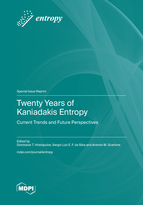Twenty Years of Kaniadakis Entropy: Current Trends and Future Perspectives
A special issue of Entropy (ISSN 1099-4300). This special issue belongs to the section "Statistical Physics".
Deadline for manuscript submissions: closed (31 December 2023) | Viewed by 39113
Special Issue Editors
Interests: statistical physics; space–time statistics; machine learning; hydrology; climate change; brain connectivity
Special Issues, Collections and Topics in MDPI journals
Interests: geophysics; statistical physics; image processing; inverse problems; data analysis
Special Issues, Collections and Topics in MDPI journals
Interests: non-extensive statistical mechanics; nonlinear Fokker–Planck equations; information geometry; nonlinear Schrödinger equation; quantum groups and quantum algebras; complex systems
Special Issues, Collections and Topics in MDPI journals
Special Issue Information
Dear Colleagues,
Starting with three influential papers twenty years ago [Physica A 296, 405 (2001); Phys. Rev. E 66, 056125 (2002); Phys. Rev. E 72, 036108 (2005)], Giorgio Kaniadakis has pioneered the extension of Boltzmann's Stosszahlansatz (molecular chaos hypothesis) in the framework of special relativity by proposing a new entropy, which emerged as the relativistic generalization of the Boltzmann–Shannon entropy. The Kaniadakis entropy generates power-law tailed statistical distributions, which in the classical limit reduce to the Maxwell–Boltzmann exponential distribution.
This new entropy, also known as κ-entropy or κ-deformed entropy, is considered as one of the most viable candidates for explaining the experimentally observed power-law tailed statistical distributions in various physical, natural, and artificial, complex systems.
Following the introduction of the Kaniadakis entropy, more than 150 statistical physics papers contributed by more than 200 scientists have been published on the subject. Relevant advances have been made in the physical foundations and mathematical formalism of the theory, as well as its applications in statistical physics and thermodynamics, quantum statistics, quantum theory, plasma physics, nuclear fission, particle physics, astrophysics and cosmology, seismology and geophysics, waveform inversion, image processing, machine learning, networks, information theory and statistical sciences, fractal theory, genomics, biophysics, economics, finance, social sciences, and complex systems, among other topics.
The study of the Kaniadakis entropy and related functions is emerging as a rapidly developing research field which attracts a steadily increasing number of researchers from different countries and spans an ever-increasing domain of applications.
This Special Issue aims to collect high-quality review and original research papers, based on statistical physics and related fields, which focus on the Kaniadakis entropy and related probability distributions. The scope of this Special Issue includes papers focusing on mathematical formalism, theoretical foundations, and applications in all fields of science. Contributions that aim to provide synthesis of novel or recent results and/or address future prospects in this field are also welcome.
Dr. Dionissios T. Hristopulos
Dr. Sergio Luiz E. F. da Silva
Dr. Antonio M. Scarfone
Guest Editors
Manuscript Submission Information
Manuscripts should be submitted online at www.mdpi.com by registering and logging in to this website. Once you are registered, click here to go to the submission form. Manuscripts can be submitted until the deadline. All submissions that pass pre-check are peer-reviewed. Accepted papers will be published continuously in the journal (as soon as accepted) and will be listed together on the special issue website. Research articles, review articles as well as short communications are invited. For planned papers, a title and short abstract (about 100 words) can be sent to the Editorial Office for announcement on this website.
Submitted manuscripts should not have been published previously, nor be under consideration for publication elsewhere (except conference proceedings papers). All manuscripts are thoroughly refereed through a single-blind peer-review process. A guide for authors and other relevant information for submission of manuscripts is available on the Instructions for Authors page. Entropy is an international peer-reviewed open access monthly journal published by MDPI.
Please visit the Instructions for Authors page before submitting a manuscript. The Article Processing Charge (APC) for publication in this open access journal is 2600 CHF (Swiss Francs). Submitted papers should be well formatted and use good English. Authors may use MDPI's English editing service prior to publication or during author revisions.
Benefits of Publishing in a Special Issue
- Ease of navigation: Grouping papers by topic helps scholars navigate broad scope journals more efficiently.
- Greater discoverability: Special Issues support the reach and impact of scientific research. Articles in Special Issues are more discoverable and cited more frequently.
- Expansion of research network: Special Issues facilitate connections among authors, fostering scientific collaborations.
- External promotion: Articles in Special Issues are often promoted through the journal's social media, increasing their visibility.
- Reprint: MDPI Books provides the opportunity to republish successful Special Issues in book format, both online and in print.
Further information on MDPI's Special Issue policies can be found here.









